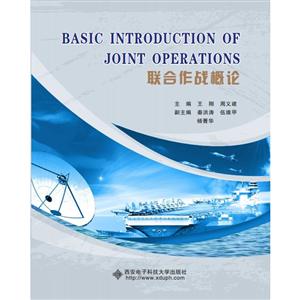-
>
中医基础理论
-
>
高校军事课教程
-
>
思想道德与法治(2021年版)
-
>
毛泽东思想和中国特色社会主义理论体系概论(2021年版)
-
>
中医内科学·全国中医药行业高等教育“十四五”规划教材
-
>
中医诊断学--新世纪第五版
-
>
中药学·全国中医药行业高等教育“十四五”规划教材
联合作战概论 版权信息
- ISBN:9787560652221
- 条形码:9787560652221 ; 978-7-5606-5222-1
- 装帧:一般胶版纸
- 册数:暂无
- 重量:暂无
- 所属分类:>
联合作战概论 本书特色
Contents: Basic issues of Joint Operations are dedicated in the book. The contents include basic concepts, the mechanism, function and organization of Joint Operations; joint /combined cooperation and interoperability; command and control (C2); information support system of Joint Operations; and advanced theories in post information age, i.e. Network Centric Warfare (NCW) and Cyberspace Operations (CO). This book can be used as a teaching book for overseas students from English-speaking countries, a teaching material for domestic undergraduate and postgraduate level military basic theory courses, and a research reference for Joint Operations. 内容简介:本书系统阐述了联合作战的基本问题,包括联合作战的基本概念、机制、功能与组织,联合作战中的联合、协同与互操作,联合作战的指挥与控制(C2),联合作战的信息支持系统,后信息时代联合作战的前沿理论,如网络中心战(NCW)和网络空间作战(CO)等。本书可作为英语国家留学生的教学用书,也可作为国内本科、研究生层次军事基础理论课程教材和联合作战专题科研参考资料。
联合作战概论 内容简介
Contents: Basic issues of Joint Operations are dedicated in the book. The contents include basic concepts, the mechanism, function and organization of Joint Operations; joint /combined cooperation and interoperability; command and control (C2); information support system of Joint Operations; and advanced theories in post information age, i.e. Network Centric Warfare (NCW) and Cyberspace Operations (CO). This book can be used as a teaching book for overseas students from English-speaking countries, a teaching material for domestic undergraduate and postgraduate level military basic theory courses, and a research reference for Joint Operations. 内容简介:本书系统阐述了联合作战的基本问题,包括联合作战的基本概念、机制、功能与组织,联合作战中的联合、协同与互操作,联合作战的指挥与控制(C2),联合作战的信息支持系统,后信息时代联合作战的前沿理论,如网络中心战(NCW)和网络空间作战(CO)等。本书可作为英语国家留学生的教学用书,也可作为国内本科、研究生层次军事基础理论课程教材和联合作战专题科研参考资料。
联合作战概论 目录
-
婴幼儿护理师
¥32.4¥38 -
公司理财-(原书第11版)
¥83.3¥119 -
叙事医学
¥33.2¥39 -
营销沟通技巧
¥34¥36 -
港口职工教育统编教材:装卸机械电气设备与维修
¥20.2¥48





















